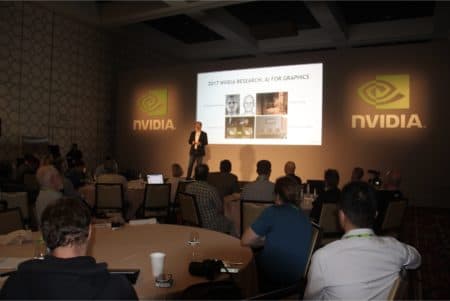Continued from page 1
Low-Level Graphics APIs
If we are going to talk about VR, AR, and MR, we must talk about the low-level GPU API’s like Vulkan and Metal that speed up GPU performance including better frame rate and rendering times. Vulkan from the Khronos Group and Metal from Apple are low-level GPU API’s. They work differently from OpenGL as OpenGL goes through a deeper software layer before accessing the GPU while Vulkan and Metal have near direct access to the GPU.
Vulkan is a graphics and computer API consisting of procedures and functions that specify, share programs, computer kernels, objects and operations involved in producing high-quality color graphical images in 3D. Vulkan is also a programmable pipeline and state driven, fixed function stages are invoked by a set of specific drawing operations. It means it is a cross platform solution available for developers of desktops and mobile solutions.
Apple’s Metal API
Metal 2 API provides near direct access to the GPU allowing more efficient graphics and compute potential for your apps in iOS, macOS, and tvOS. It is a low-overhead architecture with precompiled shaders, fine-grained resource control, and multithreading support. These low-level API’s boost performance across multiple platforms by taking control of the rendering pipeline. Epic announced during SIGGRAPH that Vulkan would be the default API in Linux Games on the Unreal Engine.
When Apple introduced Metal v.1, Epic built in support for Metal in UE v. 4.3 on the Mac. Epic was one of the first to support Metal when Apple unveiled the API at WWDC in 2014 with Apple’s Zen Garden demo and showed support for Metal 2 in the Star Wars VR demo. Khronos also released OpenGL 4.6 with SPIR-V Support. SPIR-V is a Khronos defined standard that allows simplifying shader authoring and management pipelines while providing source shading language flexibility. OpenGL 4.6 adds support for ingesting SPIR-V shaders.
MORE: SIG: The Khronos Group Releases Major Update to Graphics API—OpenGL 4.6 with SPIR-V Support
OpenGL 4.6 adds support for ingesting SPIR-V shaders ensuring SPIR-V shaders will be widely accessible in OpenGL implementations. There have been mixed benchmarks if Vulkan and Metal are faster, as in some cases OpenGL is faster at other tasks. I expect this to change in the future. Autodesk, The Foundry, and a few other developers also announced their support for Metal 2 at the WWDC event this past year, but implementation will take time and many companies are waiting for the release of the new iMac Pro before making further announcements.

04 – AMD announces that they have combined the power of the CPU and GPU together. (image: Copyright Akiko Ashley for Architosh. All rights reserved.)
As VR and AR technology companies are growing in the market space, AMD and NVIDIA are competing like never before. The good thing is that competition means better solutions for users. AMD and NVIDIA have different marketing philosophies, but they both want to deliver fast, efficient solutions to their customers. AMD had a huge presentation party on July 30th where the focus was not just on the GPU but the ability of the hardware to use both CPU and GPU simultaneously to get the biggest bang for the buck. NVIDIA’s presentation was a bit different focus on the “AI Revolution”. Today NVIDIA’s GPU’s simulates human intelligence that is acting as a brain for computers, self-driving cars, and robots.

05 – NVIDIA AI-focused presentation panel discussion. (image: Copyright, Akiko Ashley for Architosh. All rights reserved.)
As we move forward in the worlds of VR/AR/MR we are going to see a lot more of this technology grow, and the new iMac Pro will be part of the revolution. It will be interesting to see the future for both low-level graphic API’s and if they replace OpenGL or DirectX. Apple’s iMac Pro will be Apple’s first hardware Pro solution to this new market landscape. Metal will help this iMac Pro be able to run higher frame rates that are needed in VR/AR/MR and render real time 3D content. Unreal Engine and Unity will be providing support for Apple’s Metal 2. Twinmotion 2018 will now run natively on the Mac giving architects a new real time rendering solution, Chaos Groups announcement of VRay for Unreal expands tools for architectural visualization in a new way. Unity gives you cinematic rendering using Octane, plus control of individual elements in Cinemachine/Timeline. Architects can now build interactive solutions for their clients using a variety of new tools. VR/AR/MR will give them a whole new world to consider when applying their expertise.




Reader Comments
Comments for this story are closed